The SSD Relapse: Understanding and Choosing the Best SSD
by Anand Lal Shimpi on August 30, 2009 12:00 AM EST- Posted in
- Storage
Why SSDs Care About What You Write: Fragmentation & Write Combining
PC Perspective's Allyn Malventano is a smart dude, just read one of his articles to figure that out. He pieced together a big aspect of how the X25-M worked on his own, a major key to how to improve SSD performance.
You'll remember from the Anthology that SSDs get their high performance by being able to write to multiple flash die across multiple channels in parallel. This works very well for very large files since you can easily split the reads and writes across multiple die/channels.
Here we go to write a 128KB file, it's split up and written across multiple channels in our tiny mock SSD:
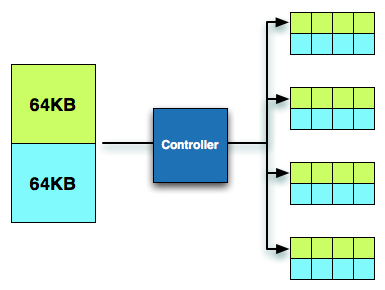
When we go to read the file, it's read across multiple channels and performance is once again, excellent.
Remember what we talked about before however: small file random read/write performance is actually what ends up being slowest on hard drives. It's what often happens on a PC and thus we run into a problem when performing such an IO. Here we go to write a 4KB file. The smallest size we can write is 4KB and thus it's not split up at all, it can only be written to a single channel:
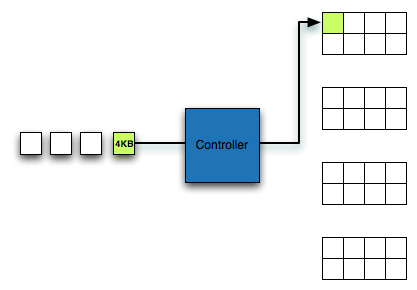
As Alyn discovered, Intel and other manufacturers get around this issue by combining small writes into larger groups. Random writes rarely happen in a separated manner, they come in bursts with many at a time. A write combining controller will take a group of 4KB writes, arrange them in parallel, and then write them together at the same time.
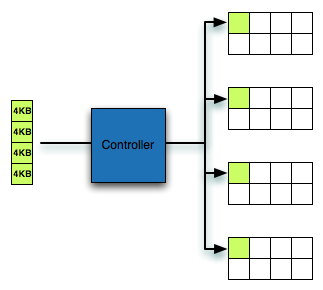
This does wonders for improving random small file write performance, as everything completes as fast as a larger sequential write would. What it hurts is what happens when you overwrite data.
In the first example where we wrote a 128KB file, look what happens if we delete the file:
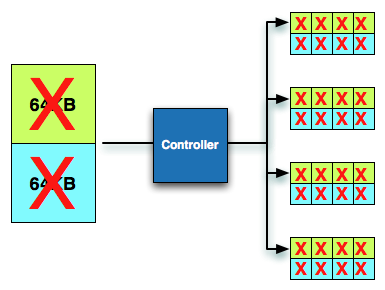
Entire blocks are invalidated. Every single LBA in these blocks will come back invalid and can quickly be cleaned.
Look at what happens in the second example. These 4KB fragments are unrelated, so when one is overwritten, the rest aren't. A few deletes and now we're left with this sort of a situation:
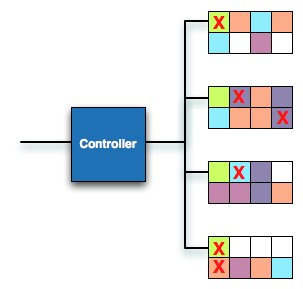
Ugh. These fragmented blocks are a pain to deal with. Try to write to it now and you have to do a read-modify-write. Without TRIM support, nearly every write to these blocks will require a read-modify-write and send write amplification through the roof. This is the downside of write combining.
Intel's controller does its best to recover from these situations. That's why its used random write performance is still very good. Samsung's controller isn't very good at recovering from these situations.
Now you can see why performing a sequential write over the span of the drive fixes a fragmented drive. It turns the overly fragmented case into one that's easy to deal with, hooray. You can also see why SSD degradation happens over time. You don't spend all day writing large sequential files to your disk. Instead you write a combination of random and sequential, large and small files to the disk.










295 Comments
View All Comments
nemitech - Monday, August 31, 2009 - link
opps - not ebay - it was NEWEGG.Loki726 - Monday, August 31, 2009 - link
Thanks a ton for including the pidgin compiler benchmarks. I didn't think that HD performance would make much of a difference (linking large builds might be a different story), but it is great to have numbers to back up that intuition. Keep it up.torsteinowich - Monday, August 31, 2009 - link
HiYou write that the Indilinx wiper tool collects a free page list from the OS, then wipes the pages. This sounds like a dangerous operation to me since the OS might allocate some of these blocks after the tool collects the list, but before they are wiped.
Have you received a good explanation for Indilinx about how they ensure file system integrity? As far as i know Windows cannot temporarily switch to read-only mode on an active file system (at least not the system drive). The only way i could see this tool working safely would be by booting off a different media and accessing the file system to be trimmed offline with a tool that correctly identifies the unused pages for the particular file system being used. I could be wrong of course, maybe windows 7 has a system call to temporarily freeze FS writes, but i doubt it.
has407 - Monday, August 31, 2009 - link
It: (1) creates a large temporary file (wiper.dat) which gobbles up all (or most) of the free space; (2) determines the LBA's occupied by that file; (3) tells the SSD to TRIM those LBA's; and then (4) deletes the temporary file (wiper.date).From the OS/filesystem perspective, it's just another app and another file. (A similar technique is used by, e.g., sysinternals Windows SDelete app to zero free space. For Windows you could also probably use the hooks used by defrag utilities to accomplis it, but that would be a lot more work.)
cghebert - Monday, August 31, 2009 - link
Anand,Great article. Once again you have outclassed pretty much every other site out there with the depth of content in this review. You should start marketing t-shirts that say "Everything I learned about SSDs I learned from AnandTech"
I did have a question about gaming benchmarks, since you made this statement:
" but as you'll see later on in my gaming tests the benefits of an SSD really vary depending on the game"
But I never saw any gaming benchmarks. Did I miss something?
nafhan - Monday, August 31, 2009 - link
Just wanted to say awesome review.I've been reading Anandtech since 2000, and while other sites have gone downhill or (apparently) succumbed to pressure from advertisers, you guys have continued to give in depth, critical reviews.
I also appreciate that you do some real analysis instead of just throwing 10 pages of charts online.
Thanks, and keep up the good work!
zysurge - Monday, August 31, 2009 - link
Awesome amazing article. So much information, presented clearly.Question, though? I have an Intel G2 160GB drive coming in the next few days for my Dell D830 laptop, which will be running Windows 7 x64.
Do I set the controller to ATA and use the Intel Matrix driver, or set it to AHCI and use Microsoft's driver? Will either provide an advantage? I realize neither will provide TRIM until Q4, but after the firmware update, both should, right?
Thanks in advance!
ggathagan - Wednesday, September 16, 2009 - link
From page 15 (Early Trim support...):Under Windows 7 that means you have to use a Microsoft made IDE or AHCI driver (you can't install chipset drivers from anyone else).
Mumrik - Monday, August 31, 2009 - link
but I can't live with less than 300GB on that drive, and SSDs in usable sizes still cost more than high end video cards :-(I really hope I'll be able to pick up a 300GB drive for 100-200 bucks in a year or so, but it is probably a bit too optimistic.
Simen1 - Monday, August 31, 2009 - link
This is simply wrong. Ask anyone over 10 years if they think this mathematical statement is true or false. 80 can never equal 74,5.Now, someone claims that 1 GB = 10^9 B and others claim that 1 GB is 2^30 B. Who is really right? What does the G and the B mean? Who defines that?
The answers is easy to find and document. B means Byte. G stands for Giga ans means 10^6, not 2^30. Giga is defined in the international system of units, SI.
No standardization organization have _ever_ defined Giga to be 2^30. But IEC, International Electrotechnical Commission, have defined "Gi" to 2^30. This is supposed to be used for digital storage so people wont be confused by all the misunderstandings around this. Misunderstandings that mainly comes from Microsoft and quite a few other big software vendors. Companies that ignore the mathematical errors in their software when they claim that 80GB = 74,5 GB, and ignore both international standards on how to shorten large numbers.